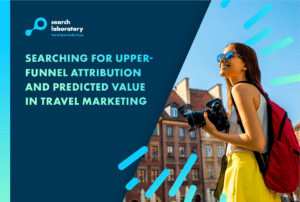
![]() Insights
Insights
Utilizing machine learning and automation is a growing trend across industries. By automating certain manual processes, you begin freeing up time for the human brain to work on more higher-level, strategic activity.
Machine learning’s ability to solve problems and analyze huge sets of data more efficiently than the human brain makes for improved performance and reduced costs for businesses.
The depth of analysis makes it possible to gather thousands of micro details about your audience, your target market and everything in between. Through analyzing patterns and trends, detailed insights allow you to pivot your strategy towards motives that matter and make informed decisions on the most valuable leads.
By implementing the likes of revenue management systems, data warehouses and machine learning, you’re not only freeing up time but also avoiding missing out on opportunities. This could be increasing the price you sell your hotel rooms in moments of high demand or being able to quantify missed revenue caused by out-of-stock products.
A MEMSQL study revealed that 61% of marketers cited artificial intelligence and machine learning as the most significant feature of their data strategy.
Focusing on the quality of customers and leads is the key to evolving your marketing strategy to the next level.
Machine learning opens the opportunity to build a model predicting the likely value of a person based on their known behaviors, attributes and actions. For example, looking at the journey they have taken through your website, which products they have engaged with, if they have purchased before, and much more.
This makes it possible to identify users that are most interested in particular products so you can place them in targeted audiences for retargeting.


There are many solutions and approaches to take, but an excellent first step is simply getting your CRM data into a place where it can be accessed for modeling. We use Google BigQuery and follow a process that enables us to join online activity through Google Analytics (GA) with all the offline data held within a CRM.
Taking this a step further, we implement a soft login solution to the website that enables us to maintain a user’s ID each time they provide identifiable information.
For example, a user who requests a brochure will be assigned an ID within the CRM. This same ID is then used each time they identify themselves on the website so that GA can better join the dots and we are less reliant on all actions occurring within the cookie window of a singular device.
This allows you to create audiences for categories of users based on how likely they are to convert making for a more efficient and effective way of optimizing your remarketing budget.
The more data is collected, the more opportunities you will have to create better personalized online experiences than ever before. Moving away from segmenting users with rule-based personalization, you can now utilize algorithms to deliver one-to-one-like experiences offering bespoke recommendations and navigation around your site.
It’s possible to harness machine learning to build user profiles and automatically suggest products and messaging based on the patterns and progression of their behavior. For example, if you purchased baby products today, that data would evolve over time as the algorithm recognizes the growth of the child and automatically suggests products to suit this timeline. Since Amazon adopted this model, sales witnessed a 29% growth within 12 months.
Personalization through machine learning is a highly efficient method of matching the right content to the right customers. Aligning your strategy to buyers’ habits and behaviors naturally directs your brand down a path of digital maturity, improving customer engagement whilst growing in both value and relevance.
Automation and machine learning algorithms have the potential to protect your business from large influxes and real-time happenings that can carry significant financial impact.
Already, Google Ads’ smart bidding uses machine learning to adjust bids in real-time to achieve campaign targets. Data-driven attribution is also now default in GA4, analyzing huge sets of data and deciding how much credit to attribute to each touchpoint in a user journey.
Given the rapid nature of the many variables that can impact prices, revenue management systems are able to provide updates of any business that comes in to protect yourself against the likes of events, weather or anything that presents an opportunity to either increase or lower your prices to stay ahead of competition.
Often these systems are managed by humans, although a lot of decisions are automated to avoid missed opportunities. Lennert De Jong, former Chief Commerical Officer at Citizen M Hotels explained how their system has saved several large influxes due to events in London. “The system will inform you if something is going on, providing recommendations to increase your price by x amount and ask, do you want to implement this?”
Implementing automated processes like this not only frees up the human brain for higher-level strategy, but also creates space for advanced algorithms to perform more efficiently and on a much larger scale than humanly possible.

As we move further into the cookie-less landscape, moving closer to your audience’s behaviors and collecting as much first-party data as possible is key to building a sustainable strategy. The more customer data you collect, the more effective your machine learning and automation will be.
As privacy regulations rise and tracking users becomes increasingly difficult, machine learning is growing in relevance. On top of automated data processing, its scope stretches into all corners of marketing. From producing data-driven insights and decision-making, to payments, personalization and much more.
The ability to leverage available data by crunching thousands of touchpoints provides a heightened perspective on your performance and brings you closer to your audience’s behaviors.
More information can be found in our recent travel whitepaper that delves deeper into machine learning, automation and predictive value.
Other topics covered in this whitepaper include:


![]() Insights
Insights

![]() Insights
Insights

![]() Insights
Insights